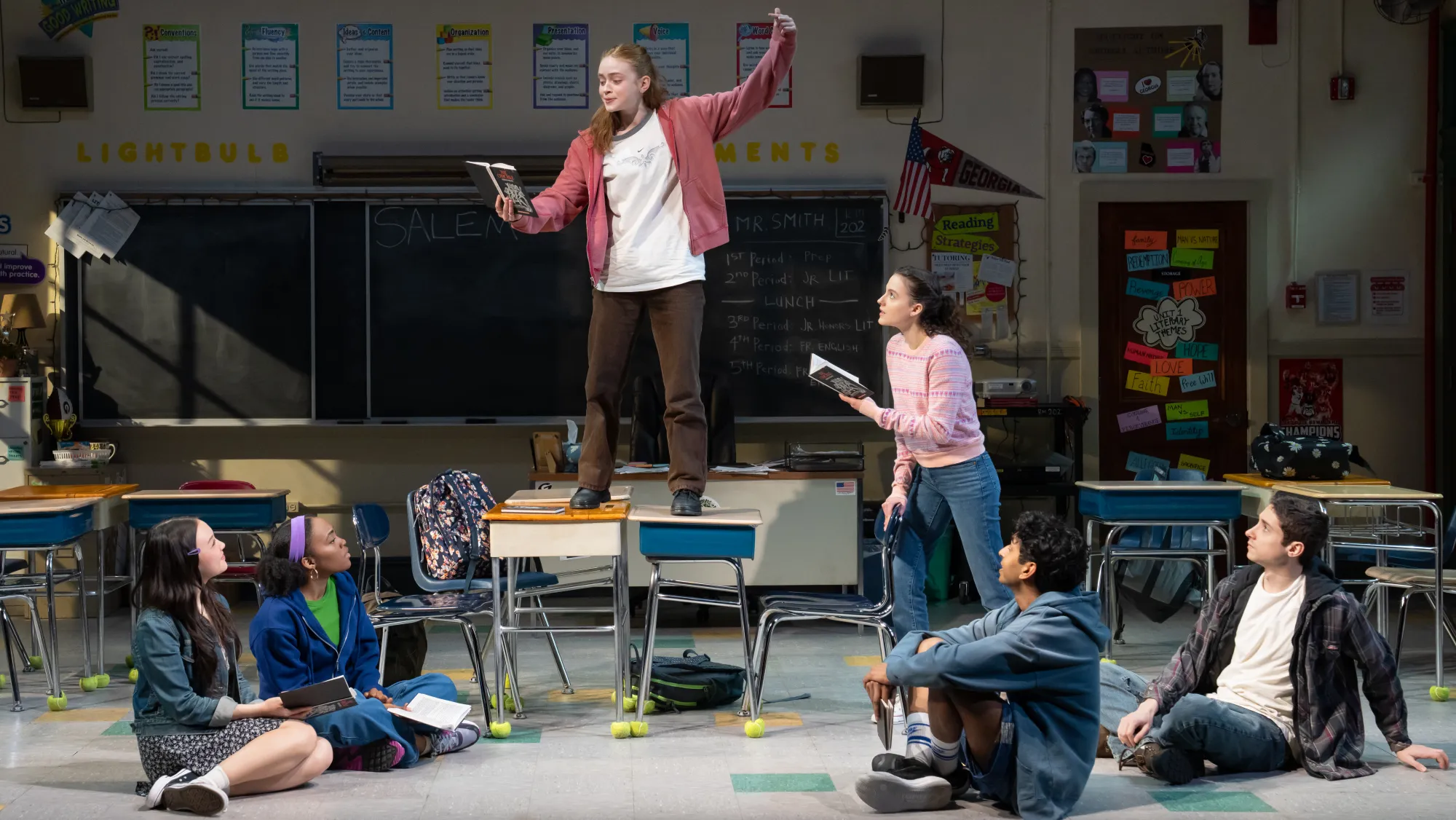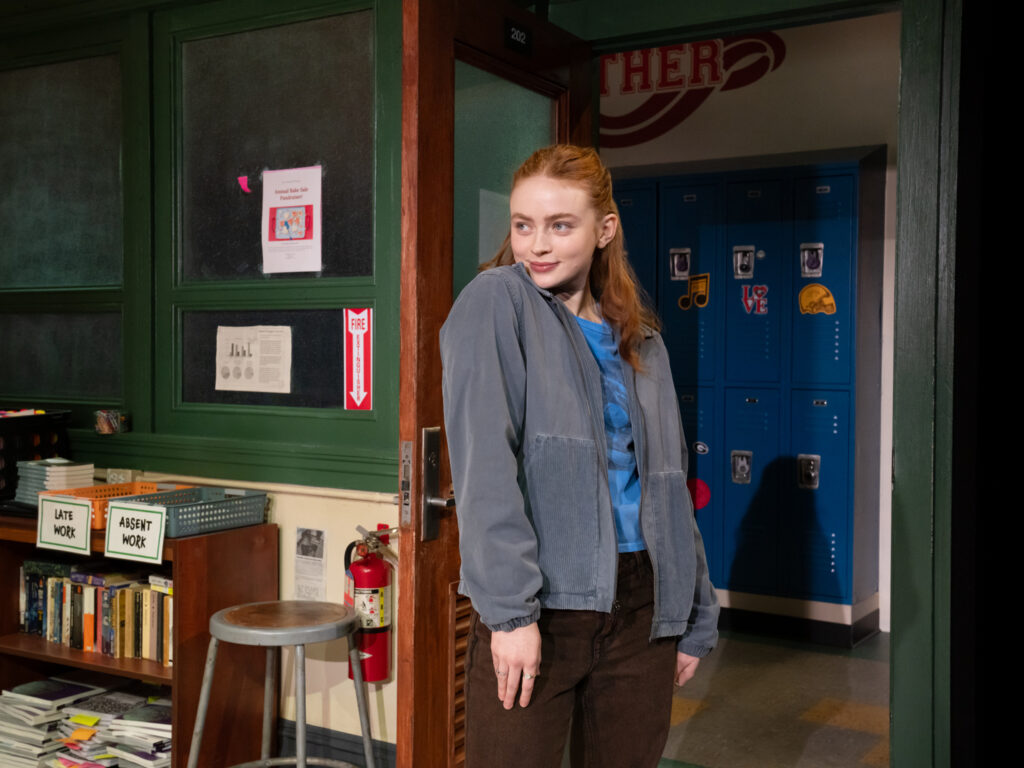The Crucible of Girlhood: Recontextualizing Teen Girls on Broadway

Teenage girls and the Broadway stage rarely walk hand-in-hand. Even in instances where teen girls are written into stories, they’re often portrayed by actors well into their thirties or older, reaching back to their high-school selves in an effort to feign an authentic teenage experience. While musicals like “Mean Girls,” “The Prom” and “Heathers” all offer teenage protagonists, the quiet nuances of the female coming-of-age are so often lost to stylization or sentimentality. That’s why writer Kimberly Belflower’s searing new play, led by “Stranger Things'” Sadie Sink, “John Proctor Is the Villain,” feels like a breath of fresh air. Thanks to a last-minute lottery win, I saw it from the front row — and I haven’t stopped thinking about it since.
Set in a high school classroom in rural Georgia at the height of the #MeToo movement, “John Proctor Is the Villain” follows a group of students studying “The Crucible” as they discover that the real witch hunt isn’t only in Salem, but in the ways that power and patriarchy continue to shape their everyday lives. The production, directed by Dayna Taymor with a sharp intimacy and bite, doesn’t just represent teenage girls; it stands back and lets them speak.
What makes this particular production so electric, beyond its bold writing and stripped-back setting, is the cast. Sink, still in her early 20s and not long removed from her own adolescence, brings a raw, lived-in quality as Shelby: a whip-smart, emotionally charged girl wrestling with betrayal, friendship and the crushing weight of complicity. Watching closely from the front row, I was struck by how much nuance she carries in even the smallest gestures: a shift in her posture, the flashes of vulnerability beyond her defiance. It feels less a performance of girlhood than a brutal embodiment of it. The authenticity and complexity of performances extend beyond Sink as well.

The entire cast, largely comprised of actors close in age to their characters, brings an authenticity that’s still all too rare in professional theater. The supporting players, composed of actors Fina Strazza, Amalia Yoo and Morgan Scott, flawlessly manifest the anxiety, fear and radical joy that inhabit young girls during this time. These aren’t stylized archetypes or broad caricatures; there are no Regina Georges or manic pixie dream girls. There are only real, flawed and politically aware young women caught in a system made to silence them.
The realism pays off. The stripped-back classroom setting — only a circle of desks, chalkboards, and the hum of fluorescent lights — feels both claustrophobic and universal. You could feel the tension boiling underneath every scene as the students debate “The Crucible.” The parallels drawn between 1692’s Salem and the lived experiences of the modern youth are just as devastating as they are clever. What sets this play apart from so many other coming-of-age stories is how fiercely and desperately it platforms the voices of teen girls without reducing them to clichés. For decades, the theater has used teenage girls as symbols of purity, rebellion, or danger. Consider “Spring Awakening,” “Carrie: The Musical” or even Miller’s Abigail Williams herself. But in “John Proctor Is the Villain,” Belflower resists that impulse. These girls do not exist to serve a metaphor; they only exist to serve the truth.
It isn’t possible to leave “John Proctor Is the Villain” unafflicted. I found myself ruminating on my own high school reading of “The Crucible” and my teenage years: what I saw, what I missed and what I failed to question. The real power of this play doesn’t lie in its critique of the canon; it’s in its critique of us. In a cultural zeitgeist that still struggles to treat teenage girls with seriousness and depth, “John Proctor Is the Villain” feels radical — not because it’s loud or flashy, but because it listens. It makes us sit in the discomfort it fosters. It lets girls be angry, confused, brilliant and wrong. And on Broadway this summer, with Sink delivering one of the most quietly gutting performances I’ve ever seen, their voices ring loud and clear.
Maybe the revolution won’t come as any kind of power ballad or viral internet monologue. Maybe it’s only a circle of desks, a bitter argument over Arthur Miller and a teenage girl at the front of the room actually being heard, for once.
Regions: Boston, New York City
